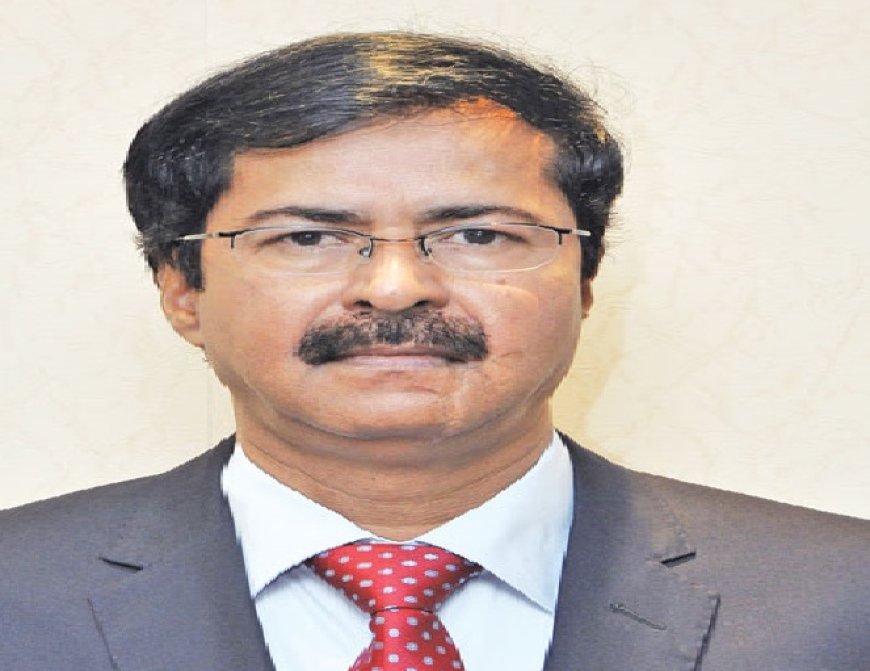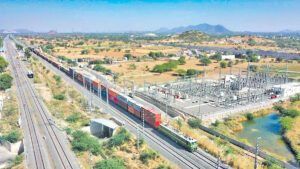L& T has so far electrified over 19,000 TKM of IR and DFC networks over the past three decades.
S V Desai, Whole Time Director & Senior Executive Vice President (Civil Infrastructure), Larsen & Toubro What are the latest initiatives of L&T in railways and metros? How is technology evolving in the Transit system domain in India especially in the light of new transit systems like High Speed and Regional Rapid Transit System?

S V Desai
Whole Time Director & Senior Executive Vice President (Civil Infrastructure), Larsen & Toubro
What are the latest initiatives of L&T in railways and metros? How is technology evolving in the Transit system domain in India especially in the light of new transit systems like High Speed and Regional Rapid Transit System?
L&T has been rapidly adopting new technologies in the domains of Metro Transit, Regional Trains and High-Speed Rail.
The Rapid Regional Transit System (RRTS) is different from a metro rail system, as it caters to passengers looking to travel relatively longer distances, quicker with fewer stops. The first in progress is the Delhi - Meerut RRTS route (82.15 km), a vital line jointly funded by ADB and AIIB. In RRTS, L&T has bagged significant orders for both civil works and track works. In civil works, L&T is constructing over 50% of the elevated structures, including associated stations through Package 3 (33 km elevated viaduct covering 7 stations, awarded in March 2020), and Package 7 (A 12km-long elevated section with 5 stations), awarded in November 2020.
From a Systems perspective, L&T won an order in Sept 2020 to manufacture, supply, and install Ballast-less Tracks for the entire Delhi- Meerut RRTS section (from Sarai Kale Khan to Modi Puram including Jangpura Stabling Yard, Duhai and Modipuram Depots). The RRTS is designed for speeds of up to 180 KMPH, with an average operational speed of 100 KMPH which is almost three times faster than that of metros. As a result, the Precast Ballastlesss Slab Track (PORR Austria type) demands stringent dimensional control and manufactured in a sophisticated factory-controlled setup. The project incorporates high level of digital technologies for sub-system management, track slab traceability and supply chain management.
India's first High Speed Rail Project, the 508 km Mumbai-Ahmedabad High Speed Rail Corridor (MAHSR) has seen rapid tender finalisation over the past couple of years. Mega packages, hitherto unseen in infrastructure domain have been won by L&T that includes major Viaducts C4 pkg (237 km), C6 pkg (87.5 km) and station cum viaduct C5 pkg (8km) overall contributing to 63% of the viaduct construction.
The project uses full span launching equipment like high-capacity straddle carriers, girder transporters and launching girders. Designed entirely inhouse with 85% locally sourced components for the first time in India, the straddle carrier developed by L&T's manufacturing facility at Kanchipuram, TN has the capacity to lift girders weighing up to 1,100 MT.
In 2022, L&T won 'T3' Track works package (116 km Vadodara to Sabarmati depot) marking our entry into India's Systems Packages for the high-speed rail project. The project adopts the Shinkansen J-Slab Track Technology (Japan) through technology transfer from Japan Railways (JR East) and involves production of high accuracy track slabs in factory controlled set up. The slab tracks ensure high level of vibration absorption to enable better ride quality, increased service life and maintainability.
We will soon attempt to replicate our success in other upcoming packages in the track and E&M domain. A high-speed train moving at 350 kmph, requires technology intensive traction systems, sophisticated cab signalling, GSM-R based wireless network and slab tracks whose accuracy is closely linked to the quality of the supporting structure which in turn enhances the ride quality. It involves massive ramp up in construction technologies in the way viaducts are constructed, installed, from project planning to logistics - all which enables a thrust towards 'Make in India'.
Besides track technology, recently we have ventured into '3rd Rail 1,500V DC Traction System' buoyed by our success in Agra Metro. DC Traction is one of the most proven systems worldwide for urban transit ensuring higher efficiency, low energy consumption and simpler infrastructure owing to lesser components.
On the Signaling front, through Dhaka Metro E&M package (20 km,16 stations), we are one of the first Indian companies to execute Communication Based Train Control and Signaling (CBTC) that is based on 'moving block technology' for minimal headways between trains and higher line capacities to address peak hour passenger traffic. Phase 1 of the project (11.5 km) has been completed and is in commercial operation.
What is your outlook on railways/metro as a greener transportation medium in the future?
The Indian Railways are perhaps the most energy efficient and green transportation systems with the least carbon footprint and aims to achieve 100% electrification by 2024 making it the world's first major railway to have a fully electrified broad gauge railway network. As of October 22, IR has electrified 82% (53,470 km) of its total broad-gauge network. IR has also commenced upgradation of their existing traction system to 2×25 kV electrification for higher speeds, greater haulage and improved system efficiency. The national transporter is also moving towards becoming a 'net zero carbon emitter' before the year 2030.
It's noteworthy to note that L&T has so far electrified over 19,000 TKM of IR and DFC networks over the past three decades. In 2022, we electrified the Roha - Verna section of the Konkan Railway (428 rkm/582 tkm) that has significantly reduced fossil fuel-based diesel loco engines resulting in savings of approx. Rs. 150 crore/year in High-Speed Diesel. The electric traction is more efficient operationally, capable of higher speeds and pollution free travel for passengers.
For the Western DFC in India, (JICA funded) L&T has executed railway 2x25KV electrification works for the entire section of the corridor (3145 tkm,EMP-4, EMP-16 pkg) employing state-of-the-art automated techniques including traction substations, switching stations and India's first gas insulated switchgears (GIS) based substation.
In the Eastern DFC, L&T is executing over 1024 tkm of 2×25 kV traction and OHE along with S&T, SCADA and 132 kV transmission and, for the mainline, we are close to completing a large electrification project, the Core EPC 7 involving various sections of Southern Railways 986 rkm/1,137 tkm.
In Metros, through Mauritius LRT system, L&T has revolutionized commuting patterns in Mauritius to offer a comfortable, safe, reliable, and greener commuting experience.
How do you visualize the emerging opportunities for contractors in railway and metros segments?
In the recent budget, Indian Railways has announced highest ever investment outlay of 2.9 lakh crore aimed at capacity augmentation and traffic decongestion in IR network. The prospects over the next 3-4 years include new line 7,000 km (Rs 70,000 crore), doubling/third line 8,000 km (Rs 80,000 crore).
On the Metro front, there is thrust in building new Metro/MRT Systems and expanding existing Metro networks as MRT facilitates Transit Oriented Development, easy movement across the city and reduced carbon footprint.
New Metros have been announced in several Tier 2 cities like Gorakhpur, Varanasi, Meerut, Vijayawada, Vizag, Dehradun, Bhubaneswar etc. Expansion of existing Metro Systems in major cities such as Mumbai, Delhi, Bangalore, Chennai, Hyderabad Airport Link, and Ahmedabad is underway.
On the International front, while we continue to focus on the neighbouring countries like Bangladesh, we are also strongly looking to expand into ASEAN, Middle East, North and East Africa - which are countries with L&T's footprint. Most importantly, we continue to target only those projects that are funded through secured sources like Government of India - Lines of Credit or through Bilateral/ Multilateral funding agencies such as JICA, EBRD, ADB etc.
 New Metros have been announced in several Tier 2 cities like Gorakhpur, Varanasi, Meerut, Vijayawada, Vizag, Dehradun, Bhubaneswar etc. Expansion of existing Metro Systems in major cities such as Mumbai, Delhi, Bangalore, Chennai, Hyderabad Airport Link, and Ahmedabad is underway. On the International front, while we continue to focus on the neighbouring countries like Bangladesh, we are also strongly looking to expand into ASEAN, Middle East, North and East Africa - which are countries with L&T's footprint. Most importantly, we continue to target only those projects that are funded through secured sources like Government of India - Lines of Credit or through Bilateral/ Multilateral funding agencies such as JICA, EBRD, ADB etc.
New Metros have been announced in several Tier 2 cities like Gorakhpur, Varanasi, Meerut, Vijayawada, Vizag, Dehradun, Bhubaneswar etc. Expansion of existing Metro Systems in major cities such as Mumbai, Delhi, Bangalore, Chennai, Hyderabad Airport Link, and Ahmedabad is underway. On the International front, while we continue to focus on the neighbouring countries like Bangladesh, we are also strongly looking to expand into ASEAN, Middle East, North and East Africa - which are countries with L&T's footprint. Most importantly, we continue to target only those projects that are funded through secured sources like Government of India - Lines of Credit or through Bilateral/ Multilateral funding agencies such as JICA, EBRD, ADB etc.
Hits: 0







